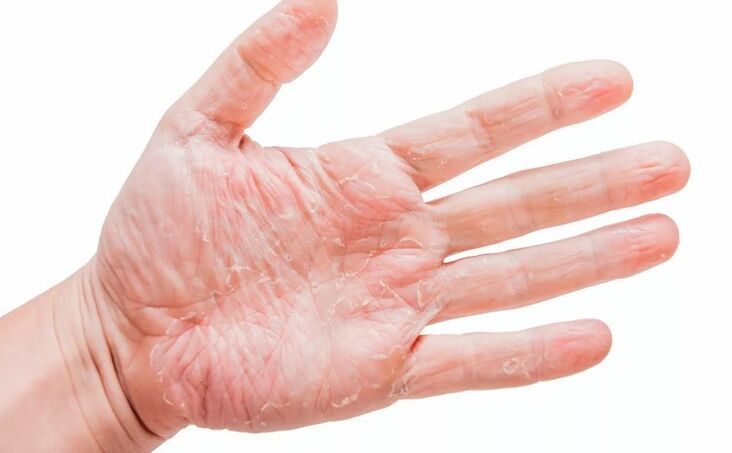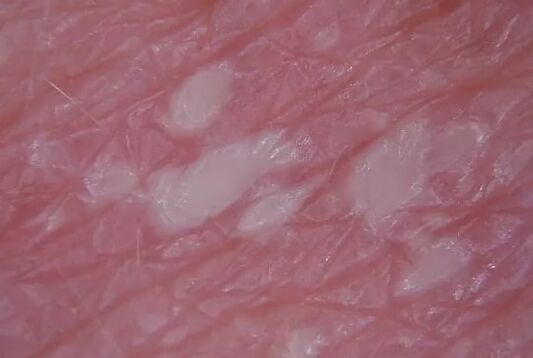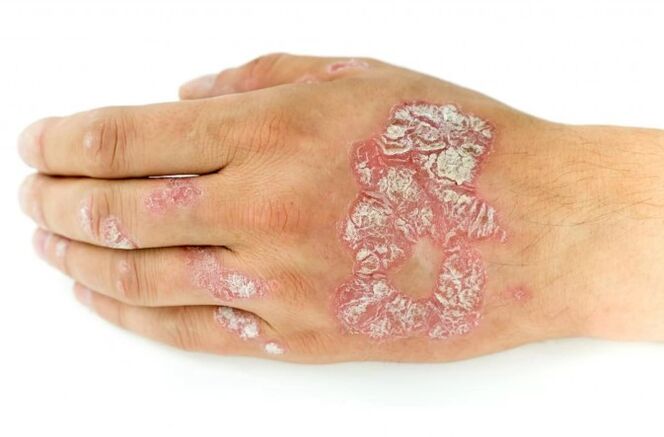Psoriasis is a chronic dermatological disease, the basis of pathogenesis of which is an abnormally rapid growth of skin cells, which leads to the appearance on the surface of the skin of the compacted areas of different colors.
Today, psoriasis has become the most common non -infectious dermatological disease.Psoriasis has no gender predisposition - men and women also often suffer from it.You can get this pathology at any age, but more often than not, the first signs of the disease seem up to 20 years.

Psoriasis is quite poor in therapy, partly due to the fact that so far, the etiology and pathogenesis of this pathology are still not clear.In addition, there is no specific means of prevention of psoriasis, because it is impossible to determine whether a person has a predisposition to the disease.
Development reasons
For the moment, scientists cannot respond unequivocally to the question "why is psoriasis developing?".Two main factors in the development of the disease are distinguished - it is a genetic predisposition and hyperreactivity of the immunity system.
It has been established to date thatThe predisposition to the development of psoriasis is inherited.But the difficulty lies in the fact that it is extremely difficult to trace how exactly this predisposition is inherited and after the influence of the factors that psoriasis can develop.
It is believed that the following factors can induce the development of psoriasis:
- Frequent skin hypothermia, as well as the effect of the dry climate on it;
- Infectious process;
- Frequent constraints;
- The use of certain groups of pharmaceutical products: non-steroidal anti-inflammatory drugs (in particular aspirin), certain hypotonic and psychotropic drugs;
Pathogenesis
For the moment, the pathogenesis of psoriasis has not finally been clarified.Two main links of pathogenesis can be distinguished:
- Violation of skin keratinization.
- Disruption of the immunity system.
Together, the above factors lead to the fact that the cells of the lower layers of the epidermis for an unknown reason begin to share very quickly.This process leads to a reactive increase in the range of the upper layer of epidermal cells, which manifests outside the skin.
Symptoms
The disease always begins acutely, without any precursor to the development of the pathological process.As a rule, the first elements of the eruption are located where the skin has been damaged.
At the beginning of the symptoms of psoriasis, papules of pink or red colors appear on the skin.This process is accompanied by itching.The size of the elements varies from a few millimeters to 1.5 centimeters (in some cases, the elements even reach large sizes).Then, the elements of the eruption are covered with easily separated silver ladders.
Sometimes psoriasis damages nail plates.This pathology looks outside the fungal nail damage and is manifested by the following symptoms:
- There are many small corners on the surface of the nail;
- The edge of the nail plate thickens and acquires a dull and yellowish color;

Another characteristic manifestation of psoriasis is psoriatic arthritis (symmetrical damage to joints and periarticular tissues).Most often, the pathological process develops in the interfanating joints of the feet and hands.At first, the disease manifests itself by pain and swelling, then the deformation of the affected joint develops, which can even lead to the disability of the patient.It should be noted that in rare cases, damage is also possible.Sometimes psoriatic arthritis develops even in the joints of the spine.
Guys
The following types of psoriasis are distinguished according to the severity and characteristics of clinical manifestations:
- Playe.This type is the most common - it is diagnosed in almost 90% of people with psoriasis.The elements of the eruption, theoretically, can occur on any area of the skin.However, the most typical locations are the lower back, the scalp and the upper and lower limb extensors (the elbow and knee area).It should be noted that with this form of psoriasis, the pathological elements do not appear on the face, the palms and the soles remain intact.Externally, this shape looks like a flaming plate covered with scales silver.When the plates are displayed under the scales, the lymph is released.With an additional injury, the plate begins to bleed.The plaque form of psoriasis is also characterized by the appearance of "paraffin lakes" if called - the confluence of several plates in an element.
- Inverted psoriasis (psoriasis of flexion or intertrigonic surfaces).This form is quite rare.The elements of the eruption have the shape of red spots without coat, which do not exceed above the surface of the skin intact.Typical location of this form of psoriasis - skin folds (axillary cavities, inguinal folds, skin under the chest in women).In addition, due to the characteristics of the location, a fungal infection often joins reverse psoriasis.
- Genital psoriasis.This form most often develops in girls, mainly in adolescence (up to 16 years old).Often, the development of the pathological process is preceded by a streptococcal infection (for example, angina of chest).Skin eruptions with rocky psoriasis resemble an ordinary allergic skin rash - small points that have a color of gray with lilac, without exceeding above the surface of the skin.These rashes may appear on any area of the skin.The skin on which the rashes are found, as a rule, has a fiery appearance.
- Pustuliia psoriasis.It is a more serious form than that above.With pustular psoriasis, small painful pusions filled with pus appear on the patient's body.This form can occur both locally and generally.With pustular psoriasis, the general condition of the patients often worsens, body temperature increases.With the generalized form of pustal psoriasis, hospitalization is necessary.
- Erytoderma is the most serious form of psoriasis.With him, almost all of the patient's skin is damaged.This form is accompanied by chills, an increase in body temperature to a high number, a high deterioration in the patient's state.This disease requires urgent medical intervention, in the absence of which a fatal result can even occur.

Severity
There are many different gradations of psoriasis in terms of gravity.However, in clinical routine practice, the simplest of them are most often used, which does not require any special research method.
Thus, distinguishThree degrees of gravity of psoriasisAccording to the prevalence of the pathological process:
- Light shape.This form is fixed in cases where the patient is affected by psoriasis of less than 3% of the skin.
- Moderate shape.This diagnosis is made with psoriasis damage from 3 to 10% of the patient's skin.
- Heavy shape.This form is presented taking into account the lesion of the skin and clinical manifestations.Thus, this form is presented with a lesion of more than 10% of the skin or with a significant deterioration of the patient's well.It should be noted that psoriasis is considered severe in the presence of psoriatic arthritis, regardless of the prevalence of the pathological process.
The course of the disease and the prognosis
Psoriasis is a disease with a wave type course, that is to say that it has periods of remission (when symptoms disappear practically) and exacerbation.As a rule, the process is aggravated during periods out of season.
The prognosis of psoriasis depends on the form of the disease and the severity.As a rule, with classic forms of psoriasis, the prognosis is favorable, but in serious forms, disability is possible and even death.
Despite the favorable prognosis in most forms of psoriasis, do not forget the social aspect of this disease.In the acute period of the disease, the skin and the hairy part of the human head are covered with coat plates, which are often perceived by others as a manifestation of any contagious disease.For this reason, those around them are starting to flee the patient, which makes him close and often depression.
Diagnosis

The basis of diagnosis is clinical manifestations of the disease, the characteristics of its current, as well as the data of the objective inspection.There are a number of characteristic symptoms determined for the diagnosis of psoriasis:
- "Psoriatic film" - If you clean the surface of the coat of the coat, then it becomes smooth and shiny.
- "Stain of stearine" - When the psoriatic elements are displayed, their surface becomes whitish, startin films appear.
- "Blood Dew" - If, after the manifestation of the above symptoms, do not stop the sling of the elements, then their surface is covered with blood droplets (capillary bleeding appears).
Three symptoms described above are called "psoriatic triad" and are the main method of diagnosing psoriasis.However, there are several additional signs which are determined at a certain stage of the disease:
- At the acute stage of psoriasis, the symptoms of pilinv are caused (the psoriatic elements are surrounded by a red edge) and Kebner (new rashes appear actively in the damaged areas of the skin).
- The stages of regression also determine the symptom of Voronov (around the elements, a brilliant light edge of small wrinkled skin is determined).
Among the laboratory and instrumental methods, the following elements are used:
- Microscopy of scales and dough with potassium hydroxide (for a differential diagnosis with fungal skin lesions).
- In complex clinical cases, with an atypical course, pathological elements use the conduct of a biopsy.
- With psoriatic arthritis, blood test indicators are examined (mainly ESR and rheumatoid factor) and lead an X -ray of affected joints (for differential diagnosis with arthritis of another etiology).

Treatment
The treatment of psoriasis is a long and complex process.Unfortunately, as psoriasis is a chronic disease, the objective of therapy is not the healing of the patient, but the achievement of prolonged remission and the prevention of exacerbations.The treatment depends on the scene, form and severity of psoriasis.It should be noted that a set of medical measures must be prescribed by a dermatologist and only after an in -depth examination of the patient and verification of the diagnosis.
Diet.The treatment of psoriasis should start with the correction of the patient's daily diet.If we are talking about general recommendations, people with psoriasis should reduce the amount of protein in the diet and increase the amount of carbohydrates due to the consumption of vegetables and fruits.It is also necessary to exclude products that can cause an exacerbation of psoriasis: alcohol, chocolate, various spicy spices, as well as limit the use of garlic and onions.It is also worth limiting the consumption of fried meat and fish, smoked meats.
In addition, when compilation of an optimal diet, the patient's predisposition to allergies to all products and, if possible, exclude them must be taken into account.The optimal diet is the use of a large amount of costs and vegetables and lean varieties of meat and fish in porridge form.
Drug treatment.For the treatment of psoriasis, pharmaceutical products are used in various forms of release: ointments, tablets, injections, etc.
In addition to local drugs, the treatment of the system is also used when drugs are prescribed in the form of tablets or injections.The following drugs are most often prescribed:
- Immunosuppressants.They have an overwhelming effect on the immunity system.It is only prescribed in serious cases which do not lend themselves to other methods of therapy, because it has a large number of side effects and is difficult to transfer.
- Cytostatic.Its action aims to reduce the cell division rate, which leads to a decrease in the development rate of psoriasis and a decrease in the coat.It is only used in very serious cases, with resistance to other therapy methods.
- Various homeopathic drugs.Unfortunately, these drugs are not suitable for all patients and do not always have the necessary effect.

Photochemotherapy.Lighting is one of the main methods of processing psoriasis.
In conclusion, it should be noted that psoriasis is a complex and not studied disease.A qualified doctor must be done by treatment.Remember that no miraculous method rented on the internet will help you get rid of psoriasis yourself.
The same can be said of folk medicine - all of its methods will only benefit in combination with basic remedies that the attending physician prescribed.
Thus, we can conclude that to succeed in treatment, the patient should only use the methods he agreed with his attending physician, as well as to observe all his recommendations.This is the only way to succeed in the treatment and prolonged remission of psoriasis.























